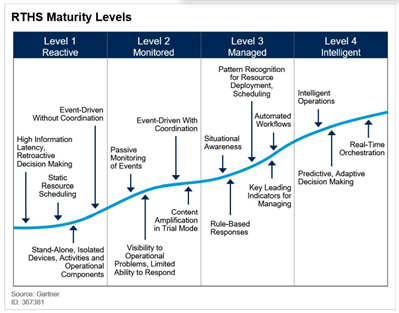One of the pandemic’s lessons is the importance of capacity management in healthcare settings. Real-Time Health Systems (RTHS) are emerging as a cornerstone of capacity management through situational awareness. Managing the flow of vital equipment in coordination with shifting capacity helps absorb surges and optimize utilization.
Capacity management in healthcare settings is a special challenge due to the dynamic nature of patient movement, specialized staff and mobile equipment. Unlike capacity management in disciplines like manufacturing where lean principles are more predictable, healthcare settings are more fluid and at times chaotic. Optimizing staff and equipment in response to shifts in patient flow can have a dramatic impact on the bottom line. And as fee-for-service billing models shift toward value-based care, the ability to streamline the patient’s course through services will have an even bigger impact on profitability.
According to Gartner, ”by 2022, 50% of HDO CIOs will cite PTCM as one of their top three organizational priorities.”* Capacity management solutions are not provided by a single vendor, rather they are a collection of solutions that operate across the enterprise. Therefore, when making vendor selections its imperative to chose solutions that operate across silos and surface data from a variety of APIs to facilitate workflows from multiple inputs.
AiRISTA’s Unified Vision Solution (UVS) is a real time location services platform (RTLS) for healthcare environments that helps “democratize” location information about patients, staff and assets. Delivered from the cloud, it can be deployed by the customer. Subscription pricing for targeted use cases means customers pay only for what they use. And integration with other apps can be accomplished with REST or web centric APIs as well as streaming interfaces expected of an IoT world.
“The RTHS transforms the HDO from a disjointed and reactive enterprise to one that is more efficient, collaborative and predictive,” according to Barry Runyon of Gartner. In his Gartner report, “Put Patient Throughput and Capacity Management at the Center of Your Performance Improvement Plan”, Runyon proposes the following RTHS Maturity Model. Capacity management is achieved at levels 3 and 4.

Insights into location of people and things is at the heart of AiRISTA’s UVS platform. The platform operates across all 4 levels of the maturity model creating a foundational component on the healthcare provider’s capacity management journey.
For a demonstration or consultation please contact us at 844-816-7127 or salesinfo@airistaflow.com.
*Barry Runyon, Gartner, “Put Patient Throughput and Capacity Management at the Center of Your Performance Improvement Plan”, August 2019





